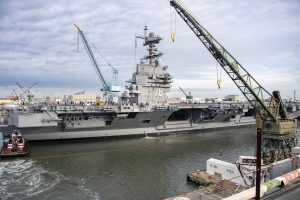The US Navy is struggling to achieve its ambition of a 355-ship fleet with a budget that remains relatively flat. In the last few days, Defense News has reported on several memos proposing cuts to new construction and retirement of existing ships in order to save money. The memos should be understood as salvos in a bureaucratic battle with the Department of Defense to establish priorities for the Navy’s future shipbuilding plans.
Perhaps not surprisingly, the cuts outlined suggest that the Navy wishes to accelerate the decommissioning of four littoral combat ships, each of which had more than a decade of expected hull life. The Navy has suggested that the first four LCS hulls, adapted for training purposes, should be retired in order to save funds. This would represent not so much the death knell of the LCS project as much as belated recognition of the failure of the promise of the program. Over the last decade, the Navy placed enormous hope in the LCS program, only to lose faith as the ships themselves suffered from technical problems and the project from a mismatch of strategic expectations. The Navy has also proposed accelerating the retirement of the aging Ticonderoga class cruisers, a suggestion that has repeatedly fallen on deaf ears in Congress. In addition, the latest proposals include cuts to future Arleigh Burke destroyer construction. Another memo suggested that the Navy would slow acquisition in the FFG(X) program, and perhaps delay construction of a Virginia-class attack submarine.
Clearly, the Navy is feeling the squeeze of the Columbia-class SSBN project, and of the ongoing difficulties with the Ford-class carriers. The latter is a cherished, if controversial, Navy priority, and the former fulfills the Navy’s commitments to U.S. strategic readiness. Of course, we should hesitate before coming to any conclusions about what the Navy’s future force structure will look like. Leaks of this sort have long been a negotiating tactic of the various parties within the Department of Defense; earlier this year, proposals to retire the USS Harry Truman were floated publicly, then quietly pushed from the agenda as part of a subsurface fight over the future of the Navy.
This much is clear: The Navy has not won the necessary battles within the Department of Defense and with the American public to accomplish the goal of a 355-ship Navy. Winning both of these battles was necessary to expanding the fleet to the extent navalists have desired, and it does not appear that the Navy won either. Indeed, the declaration of Space Force as a quasi-independent corps within the Air Force might further endanger the Navy’s position, as it may rearrange the long-term pattern of distribution of procurement funds between the services.

































